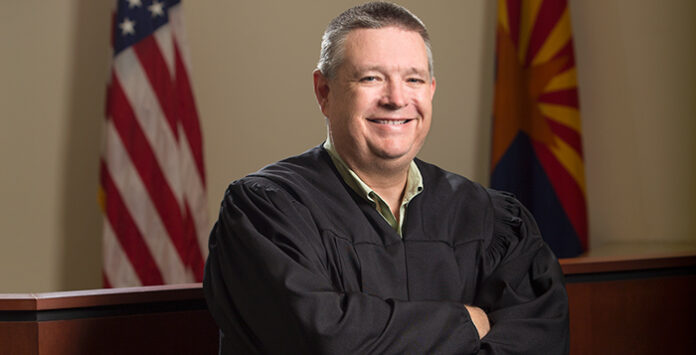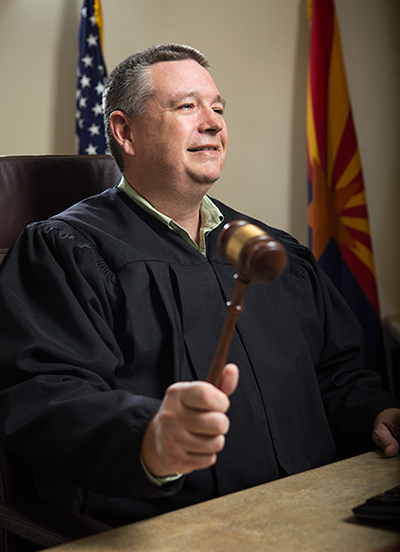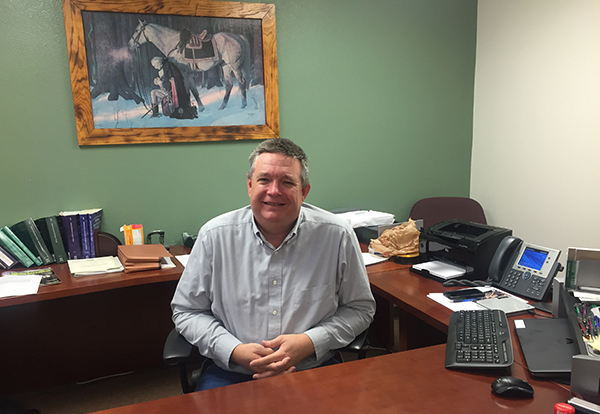
Lyle Riggs called it “an amazing team effort” involving judges, clerks, other court staff and elected officials.
But because Riggs wears the robe and is the centerpiece of the courtroom, he is the face of a major reversal at the Maricopa/Stanfield Justice Court. Now that the state has officially handed back local control of the court, Riggs is also truly in charge.
The Arizona Supreme Court returned control April 27. To celebrate, court staff partied with an appreciation luncheon.
“In terms of the core function of the court, money’s being handled correctly and cases are being managed correctly,” Riggs said. “In terms of how I operate the courtroom, I think the staff is much more cohesive. I think they’re happier from when I first got here.
“There is a better teamwork, and I think they have a better vision of what we’re trying to accomplish as a court.”
Riggs was elected justice of the peace in 2014, in the middle of scandal at the court. An audit by an independent firm of both the Justice Court and the Maricopa Municipal Court in December 2013 began an investigation into mismanagement and even the misplacement of more than $155,000. The audit showed the court did not make daily deposits, and the ensuing investigation brought more alarming details to light.
The courts share a building on Wilson Avenue. For more than 10 years, since incorporation, they also shared a judge – Scott Sulley.
In the wake of the troublesome audit, State Supreme Court Chief Justice Rebecca White Berch had Sulley reassigned. Berch’s order described the financial record-keeping as “broken down” and the court as “ceas(ing) to function properly in several key areas.”

Pinal County Superior Court Presiding Judge Stephen McCarville, who was responsible for reassigning Sulley, told the Commission on Judicial Conduct he felt he could not trust Sulley with any judicial duties. The commission found 400 final disposition reports unprocessed and stacked throughout the office.
It wasn’t just a financial mess. Accusations surfaced of bad behavior in court ranging from rudeness to ethnic bias to keeping warrants active after fines had been paid. The commission heard Sulley was not only leading an untrained staff, but he was also not allowing them to get proper training and even telling them to do things incorrectly. It was a spreading black eye for Maricopa.
Sulley was later entirely removed from the bench and then disbarred.
Administrative Director of the Courts Dave Byers called the financial situation at the local court “catastrophic.”
In January 2014, the Supreme Court gave McCarville control of the Maricopa/Stanfield court. That remained the case until April 27 of this year.
“I have not experienced any situation similar to those in the Maricopa Justice/Magistrate Court but have been told by the Arizona Supreme Court that it has occurred in other jurisdictions,” McCarville said. “Thankfully, I have only been the presiding judge for three years so I am hoping this is my only experience with this situation.”
McCarville appointed interim judges while sending over experienced clerks and court staff to scour the justice court and municipal court financially. They worked overtime and weekends processing neglected reports and uncovering the misplaced funds.
“That’s a lot of work – too many years of backlog and problems and issues,” Mayor Christian Price said. “This is a court you can now trust completely. I really appreciate all the work that’s gone into it – a lot of Saturdays and lot of late nights and early mornings.”
County Supervisor Anthony Smith praised staff for its hard work to get the court “back on the right track and re-establish the integrity we expect in our court system.”
The county did foot the bill for staff to complete the endeavor.
Riggs waded into that massive effort when he took office in January 2015. He had no chief clerk at the time. Several staff members were only interim. Though there was turnover from the Sulley court, there were four clerks who stayed.
Riggs said there was personal satisfaction in that for him, and their experience in the Sulley court was invaluable as others worked to straighten out files. Two other clerks have been hired from Casa Grande.
“I’ve been here a year and a half,” Riggs said. “I’ve never had a full staff that’s been fully trained.”
One clerk just started in May to fill out that staff. Riggs estimated it takes a brand new clerk three to six months “to really get up to being fully productive.”
He said the court’s goal now is keep everybody on staff and trained and happy.
Riggs said when he came in he sat down with each staff member individually. “At that point, I told them, ‘The past is the past. You’re starting with a clean slate. Prove to me you can do the job.’ And they responded.”
Possibly the greatest challenge Riggs faced was “instilling in staff the notion that our mistakes have real impacts on real lives. If we don’t cancel a warrant timely, and someone gets arrested when they shouldn’t have, that’s real impact. If we suspend someone’s driver license mistakenly, that’s real impact.
“I think part of the disconnect was the sense that part of the work wasn’t necessarily that important and that it didn’t really matter.”
His staff now has a vision of what the court should be and pride in their work, he said.
The court was given a 61-page Action Plan to check off as it came into compliance. It still has outstanding items to complete. Though the direct oversight of Superior Court has ended, McCarville left the justice court a to-do list: Demonstrate correct financial management; demonstrate correct case management.
The court crossed the threshold for both in July and was monitored until April. Riggs said his court has hit the financial filing deadlines every time.
McCarville said both the Supreme Court and Superior Court will visit the M/S Justice Court over the next few months, and a final audit has been planned for July or August.
Riggs also keeps on eye on Supreme Court guidelines for case resolutions.
For instance, the Supreme Court determined 85 percent of driving-under-the-influence cases should be resolved in six months. Ninety percent of civil traffic violations should be resolved in three months.
Riggs said the M/S Justice Court is not quite there yet, but he watches those numbers closely. Speedy resolution is better justice, he said. And there are lingering cases from the Sulley years to still be processed.
“We’re still seeing a lot of old cases that there’s no way to resolve them until the defendants actually come in,” Riggs said. “So those will hang around for a while.”
One of the changes initiated at the Maricopa/Stanfield court was how duties were assigned to clerks. For many courts, clerks are assigned to a desk with specific duties. At the M/S court, they put three desks together and assigned clerks as a team.
“Because the cases don’t come into us evenly,” Riggs said. “One day you might have a whole bunch of civil traffic cases, so that clerk is overwhelmed, but the other clerk has a little bit less to do. Now we’re saying, ‘You come help the civil traffic clerk.’”
Judicial office supervisor Luis Lopez is “outstanding,” Riggs said. “I am thrilled with my staff. They do great work. They all know they still have to improve, and they’re all committed to it.”
The collaboration between Superior Court, Board of Supervisors, city council and the local courts “has been a really good example of what government entities can do when they decide to come together,” he said.
“What we’re being told is there is a higher level of trust. People feel like they’re being heard. And they feel like they’re being treated fairly.”
Having been JP for nearly 18 months, he can see how easily cases can get out of hand.
“We are a high-volume court,” Riggs said. “And if you don’t stay on top of things day to day, it stacks up really fast. If you don’t have staff that’s well trained, it starts to stack up. I don’t know how it got started – I wasn’t here – but based on what we’ve seen, you can’t put cases aside and say ‘I’ll get to them tomorrow.’ Because when you do that, the next day’s cases get added to that. Pretty quick you’re overwhelmed.”

This story appeared in the June issue of InMaricopa.

![MHS G.O.A.T. a ‘rookie sleeper’ in NFL draft Arizona Wildcats wide receiver Jacob Cowing speaks to the press after a practice Aug. 11, 2023. [Bryan Mordt]](https://www.inmaricopa.com/wp-content/uploads/2024/04/cowing-overlay-3-218x150.png)




![Maricopa’s ‘TikTok Rizz Party,’ explained One of several flyers for a "TikTok rizz party" is taped to a door in the Maricopa Business Center along Honeycutt Road on April 23, 2024. [Monica D. Spencer]](https://www.inmaricopa.com/wp-content/uploads/2024/04/spencer-042324-tiktok-rizz-party-flyer-web-218x150.jpg)





![Alleged car thief released without charges Phoenix police stop a stolen vehicle on April 20, 2024. [Facebook]](https://www.inmaricopa.com/wp-content/uploads/2024/04/IMG_5040-218x150.jpg)

![MHS G.O.A.T. a ‘rookie sleeper’ in NFL draft Arizona Wildcats wide receiver Jacob Cowing speaks to the press after a practice Aug. 11, 2023. [Bryan Mordt]](https://www.inmaricopa.com/wp-content/uploads/2024/04/cowing-overlay-3-100x70.png)


